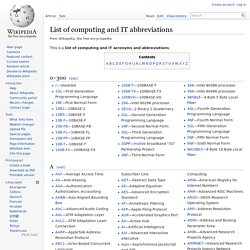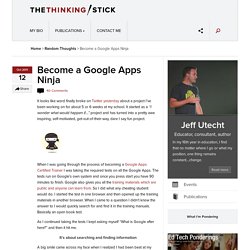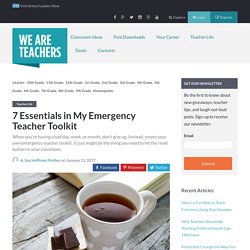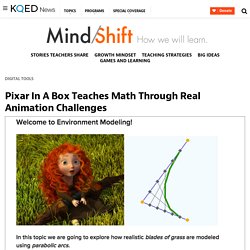

Technology and the Common Core in the Elementary Classroom. Dealing With Digital Distraction in the Classroom. EDTECH 4 BEGINNERS – New to educational technology? I can help. List of computing and IT abbreviations. From Wikipedia, the free encyclopedia.

How to Search on Google: 31 Advanced Google Search Tips. If you’re like me, you probably use Google many times a day.

But chances are, unless you're a technology geek, you probably still use Google in its simplest form. If your current use of Google is limited to typing in a few words and changing your query until you find what you’re looking for, then I’m here to tell you that there’s a better way -- and it’s not hard to learn. On the other hand, even if you are a technology geek and can use Google like the best of them already, I still suggest you bookmark this article of advanced Google search tips. Then, you’ll then have the tips on hand when you're ready to pull your hair out in frustration watching a neophyte repeatedly type in basic queries in a desperate attempt to find something.
For even more Google tips, download our free guide here. The following advanced Google search tips are based on my own experience and things that I actually find useful. Here's an overview of some of the most useful Google search tricks. Step 2) Exclude Words. Internet Tips: Understanding URLs - Full Page. If you are wondering what are URLs, you are not alone. Get help understanding URLs in this free lesson. Understanding URLs Every time you click a link on a website or type a web address into your browser, it’s a URL. URL stands for Uniform Resource Locator. Think of it like a street address, with each portion of the URL as different parts of the address, and each giving you different information.
Scheme Every URL begins with the scheme. Domain name The domain name is the most prominent part of a web address. Each segment of the domain name separated by a period is called a domain. Become a Google Apps Ninja. It looks like word finally broke on Twitter yesterday about a project I’ve been working on for about 5 or 6 weeks at my school.

It started as a “I wonder what would happen if….” project and has turned into a pretty awe inspiring, self-motivated, get-out-of-their-way, dare I say fun project. When I was going through the process of becoming a Google Apps Certified Trainer I was taking the required tests on all the Google Apps. The tests run on Google’s own system and once you press start you have 90 minutes to finish. Google also gives you all the training materials which are public and anyone can learn from. So I did what any cheating student would do. 7 Essentials in My Emergency Teacher Toolkit - WeAreTeachers.
It’s stressful being a teacher.

This is a world that few others can understand. You’re essentially a stand-in parent to 20, 30—or in my case, 150—children for seven or eight hours of the day. It’s hard not to get overwhelmed by all the well-meaning questions from kids or the phone calls and emails from parents. You’re also processing dozens of emails a day from staff and administrators, in addition to lesson planning, grading papers, teaching, consoling students, and doing behavioral management. Free Technology for Teachers.
The Current State of Educational Blogging – The Edublogger. Each year we conduct a survey on how educators are using blogs.

Our goal is to document the trends in educational blogging. We started the annual survey because we’re frequently asked for detailed information to help educators: Convince school administrators to allow blogging.Understand the benefits of blogging and how blogs are used with students.Know more about which blogging platforms are commonly used by educators (and why). Annotate images and videos — ThingLink. Pixar In A Box Teaches Math Through Real Animation Challenges. Pixar senior scientist Tony DeRose was faced with a problem that animators had never solved — how to make the hand of an old man look lifelike.

It was 1998 and he was working on the experimental short film “Geri’s Game.” DeRose needed to figure out how to make a sculpture hand model with many angular planes look smooth and skin-like on the screen. To do this he developed an algorithm using weighted averages that won him a Scientific and Technical Academy Award in 2006.
Pixar is constantly solving new technical challenges that allow its artists, designers and storytellers a broader range of movement and texture in the movies they make. Now the company is teaming up with Khan Academy to use examples like DeRose’s discovery of surface representation to show students how the math and science they’re learning in school is applied by Pixar animators. “The place we intersected was this need to pull people in,” Cruise said. “They have this more interactive intuition lesson,” Cruise said. Ideas for Inquiry-Based Learning □□□□ (by @sylviaduckworth) #edchat #education #elearning #edtech #engchat #mathchat #pblchat #sschat.
Statistics-Mean, Median, Mode, Range (tutorial) WOW! A great resource for exploring the periodic table! #EDUC661OL #TEDEd. Technology as a Tool to Support Instruction. This week, in an Education World "edu-torial," Lynne Schrum presents her personal perspective on the ways in which technology can enhance learning -- and calls on educators to take a leadership role in determining the ways in which technology is used to support educational goals.

Lynne Schrum, past president of the International Society for Technology in Education (ISTE), is an associate professor in the department of instructional technology at the University of Georgia. Her research, teachings, and writings focus on issues related to distance education, specifically online learning. Schrum also investigates the uses of technology in K-12 environments and identifies ways to support educators in the effort.
We're all familiar with the extravagant promises of technology: It will make our students smarter -- and it will do it faster and cheaper than ever before. Moreover, the promise suggests, this miracle will occur almost by osmosis. But is mere technological skill enough?